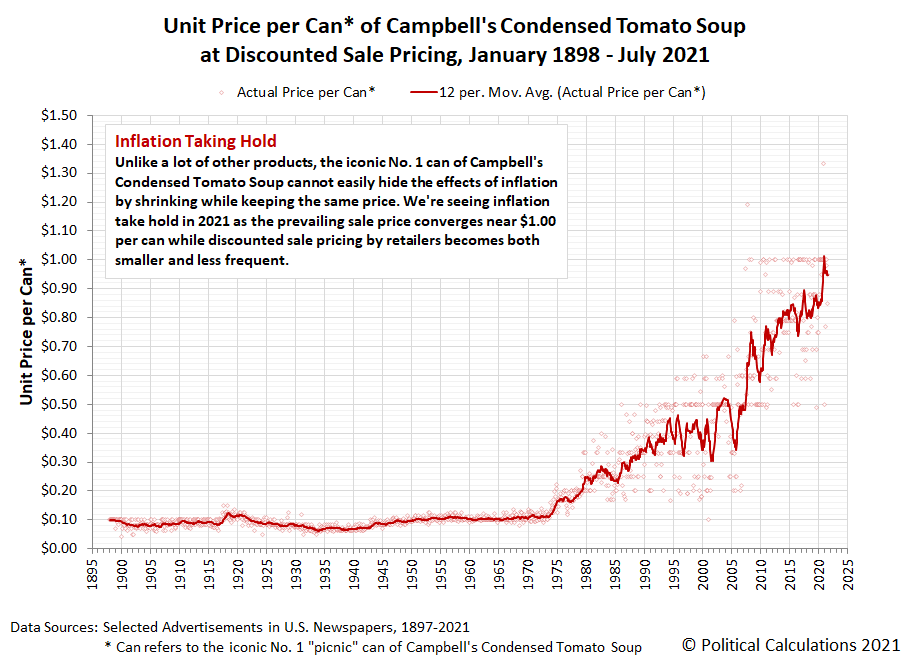Campbell's Condensed Tomato Soup has long been our favorite way to visualize the effects of inflation over time in the U.S. economy. That's because the product is defined by its iconic packaging, a No. 1 size steel can that contains the same amount of condensed tomato soup as it did when the product was first introduced to the public in the late 1800s.
For the latest in our coverage of Campbell's Tomato Soup prices, follow this link!
This relative stability in packaging however means Campbell Soup (NYSE: CPB) cannot hide the price increases it passes along to its customers through shrinkflation, which many other food producers exploit by keeping the same prices on their goods, but diminishing the amount of goods within them. When inflation drives up the costs of what they have to pay to make and transport their goods to consumers, Campbell's must increase their prices to compensate.
That's what's happening now. Campbell Soup has confirmed it is increasing prices across its product lines:
Get ready to add a few dollars to your monthly canned soup budget, because thanks to rising supply chain costs, Campbell’s is planning to raise its prices. On Wednesday, Campbell’s announced its last-quarter earnings were weaker than the company had expected. Compared to the same time period last year, profits had fallen 5% to $160 million.
“Our results were impacted by a rising inflationary environment, short-term increases in supply chain costs, and some executional pressures,” said CEO Mark Clouse....
Clouse assured investors that the company is taking steps to recover from the slump, including a new pricing strategy, which will roll out over the current quarter (which ends in early August). Across the company portfolio Campbell’s net sales decreased 14% over the last quarter, so expect this pricing strategy to affect more than just canned soup—Swanson broth, Pop Secret popcorn, Cape Cod chips, Pace salsa, Snyder’s of Hanover pretzels, V8 juice, Prego tomato sauce, SpaghettiOs, and Pepperidge Farm are all owned by Campbell’s.
Whether or not you, personally, will be paying more for these products is yet to be seen. Though retailers will be paying more for Campbell’s products, it’s ultimately up to them whether or not to absorb the higher costs, or pass them onto consumers.
The markup between wholesale and retail prices give retailers some flexibility in how they might choose to pass their increased costs along to consumers. And that is where we can show how that works, because we've tracked the prices consumers have paid for Campbell's Condensed Tomato Soup since the product rolled out onto grocery store shelves in the late 1800s.
For products like Campbell's Condensed Tomato Soup, retailers pass along their cost increases to consumers by offering fewer and smaller discounts. This marketing strategy lets them hold their shelf prices relatively stable, but only until inflationary pressures rise enough to force retailers to increase their shelf price. Once they do, their higher markups allow them to regain the ability to offer larger discounts.
You can see that dynamic playing out in this chart as prices have periodically stepped upward in 5 to 10 cent intervals since the U.S. government ended its failed attempt to stop inflation through price controls in 1974. As prices have risen, deep discounting becomes much less common and eventually the low prices consumers were once able to pay becomes a thing of the past.
In 2021, the price of Campbell's Condensed Tomato Soup is converging near a shelf price of $1.00 per 10.75 ounce can. In July 2021, the trailing twelve month average discounted sale price is $0.95 per can, which has fallen from a seasonal peak of $0.99 per can in December 2020 thanks largely to some unique pandemic-driven supply and demand dynamics. We think we'll start seeing higher retail shelf prices in the very near future to confirm the permanence of 2021's inflation.
Labels: inflation, personal finance, soup
Welcome to the blogosphere's toolchest! Here, unlike other blogs dedicated to analyzing current events, we create easy-to-use, simple tools to do the math related to them so you can get in on the action too! If you would like to learn more about these tools, or if you would like to contribute ideas to develop for this blog, please e-mail us at:
ironman at politicalcalculations
Thanks in advance!
Closing values for previous trading day.
This site is primarily powered by:
CSS Validation
RSS Site Feed
JavaScript
The tools on this site are built using JavaScript. If you would like to learn more, one of the best free resources on the web is available at W3Schools.com.
